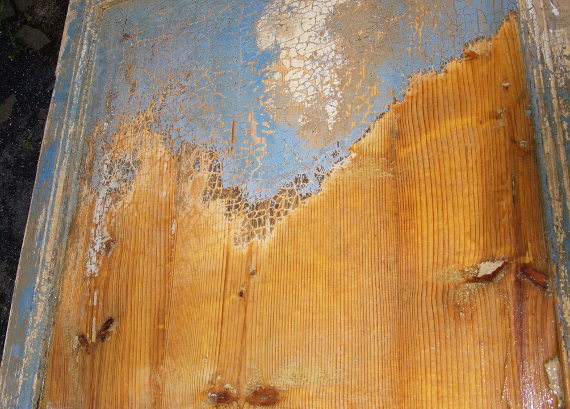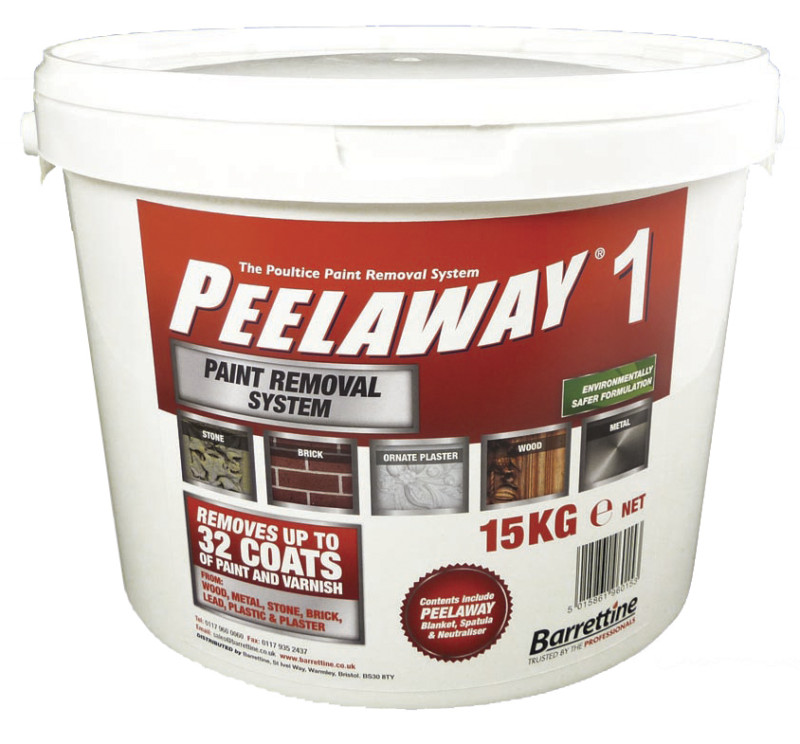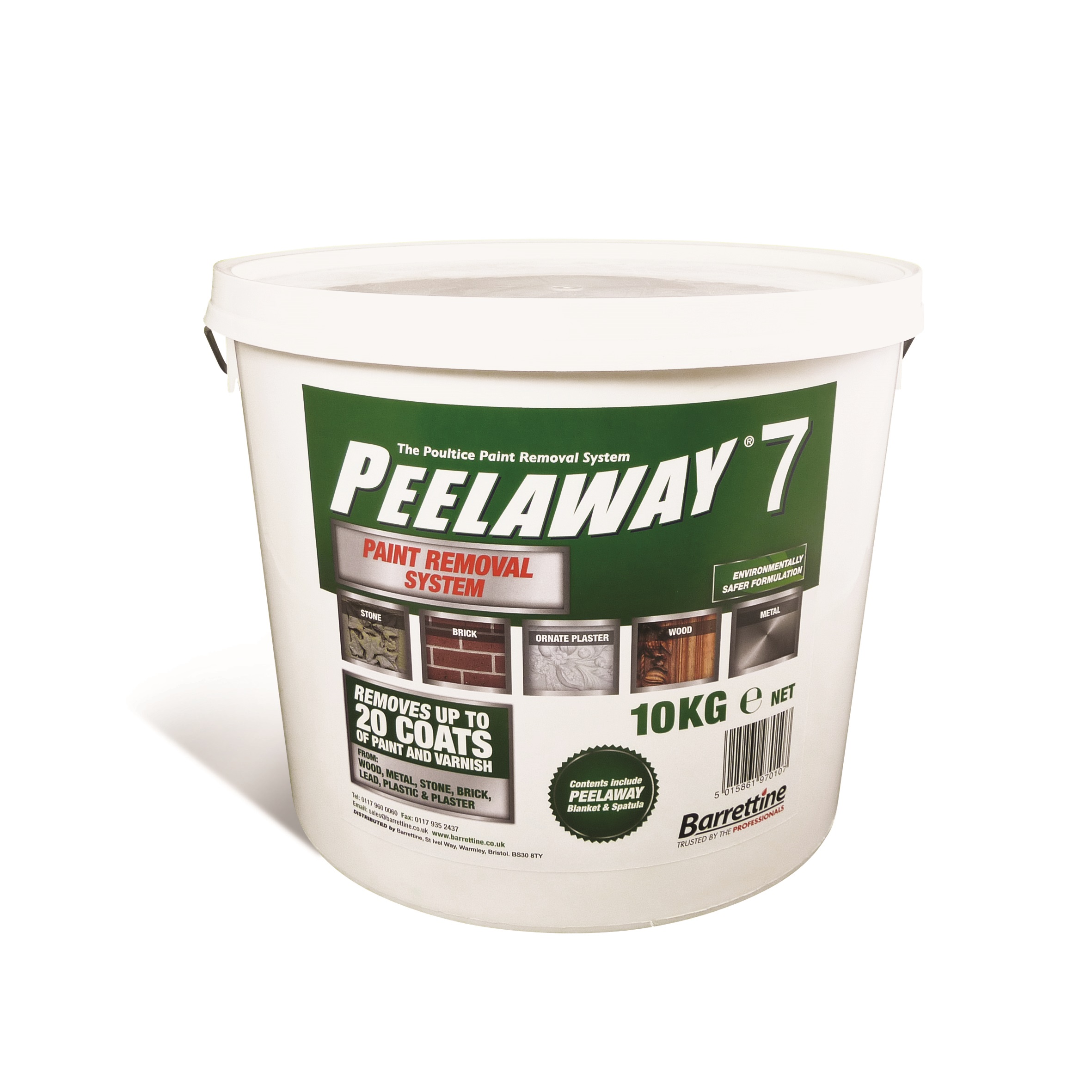Solvent paint remover takes off all kinds of finishes, even contemporary ones. They are usually very gentle on the wood and won’t damage it, which is why they’re used in the antique trade. There’s no discolouring and solvents get the wood cleaner, deeper down into the grain. On the downside, you tend to use more of it so it can end up more expensive than a caustic stripper. Solvents can also cause burns, smell awful and must only be used in a very well-ventilated space. Last of all, you might have to work a bit harder to remove heavy paint build-ups than with a caustic paint stripper.
- More expensive and messy to use
- Not so good at removing heavy paint
- No damage or staining
- A clean, finer finish
- Perfect is you want the natural look
- The best product for stripping old, damaged items like beams
Caustic paint removers take off most finishes and are particularly good at getting rid of thick layers of paint and varnish. They give off fewer fumes than solvent-based paint strippers, are cheaper and tend to work faster. On the other hand caustic products usually contain a very strong alkaline which may react with chemicals in the wood resulting in staining or scorching of the wood. This is more common with dense woods such as mahogony and some types of oak, especially old oak. Caustic substances also cause burns if you get them on your skin.
- Perfect for removing heavy paint build-ups
- Great for complicated mouldings
- Best reserved for stripping pine doors that will be repainted or stained
- Works best of all on plaster, stone and metal (May not be suitable for aluminium)

What’s the best paint stripper for wood? You can always test drive a few different products to see which best suits the job and matches your capabilities. Just carry out testing in inconspicuous areas and keep your test areas small.
Does the paint you’re stripping contain lead?
Most paints manufactured before 1960 contain lead, so if you’re stripping something older than that it’s wise to check. You can pick up a lead testing kit at your local decorating centre or DIY store.
If you find lead the British Coatings Federation have produced a leaflet about how to deal with it, which you can read here: “Old Lead Painted Surfaces – A Guide on Repainting and Removal for DIY and Professional Painters and Decorators”.
How do chemical paint strippers work?
Chemical paint stripping and varnish stripping products partially dissolve the paint or varnish. You can buy paste and gel paint stripping products, handy because they’re so thick that they stick to vertical surfaces, perfect if the item you want to strip can’t be moved.
4 steps to stripping paint from wood
- Obviously every product is slightly different. But as a general rule your first step is to apply a thick layer of stripper with an old paintbrush you can throw away afterwards. Make sure you force the product into any carved, intricate areas. Don’t paint it on like emulsion, dollop it on generously then work it into the surface
- Step away! Different products work over different timescales. Leave it alone until the product has done its thing, according to the instructions
- Once the paint has softened, scrape it off with a metal scraper. You can use steel wool to get rid of stubborn areas of paint or varnish, and old toothbrushes and wire brushes are also useful
- If there’s still some paint left, reapply the stripper and go through the process again until it’s all gone. Then, if the instructions tell you to, wash the piece to neutralise the chemicals
Paint removal from wood – safety recommendations
- Wear old clothes
- Chemical paint strippers give off fumes, some of which are toxic. If the instructions say you should only use it outdoors, obey them!
- Whatever product you use it makes sense to wear gloves and a face mask
- To avoid causing damage to the surrounding area, lay old newspaper, a tarp or drop sheet underneath the item you’re working on
- Never leave the lid off – you don’t want fumes evaporating into your workspace
paint remover and varnish remover products
We highly recommend Panther Paint and Varnish Remover, one of the best wood strippers on the market for day to day paint and varnish removal on flat surfaces. It’s great for removing varnish from wood, and paint. It’s a remarkable product, highly effective and incredibly fast, removing as many as six layers in just five minutes. It’s a gel, sticking conveniently to vertical surfaces. And it’s ideal for removing water, oil and solvent-based paints, varnishes and lacquers.
We also love Peelaway One and Peelaway Seven, both used to restore antiques and decorative items like carved fireplaces, coving and ceiling roses. They work by dissolving the paint and pulling it out of the nooks and crannies.

Peelaway 1 is better suited to paint aged 30 years and older, the old-style metal and lead based types. Peelaway 7 works better on modern paints dating from the last 30 years or so. For some projects you might need to bring both into play, using Peelaway 7 on the newer layers and Peelaway 1 on the deeper layers. Like many paint remover products it’s caustic, so always try a test patch first.

Here’s a link to an old blog post in which we give the Peelaway paint remover a rigorous trial.
Beautiful, clean, stripped wood… revealed. What’s next?
You’ve stripped it. Now it’s time to choose your wood finish. We have a huge selection of amazing products designed to breathe new beauty into your wood, whether it’s a gorgeous old floor, a splendid piece of antique or vintage furniture, a pine door or rococo picture frame.
Here are some ideas to help you get creative with your good-as-new wood:
- Polish it to a stunning mirror-like sheen with a deep-nourishing wax product
- Colour it with a vast choice of superb wood stain shades
- Oil it
- Preserve it
- Lacquer it
- Dye it
- Re-paint it
- paint and distress it for a cool shabby chic look
Any questions? We’re always delighted to help. Just get in touch. Otherwise, we wish you the best of luck with your next wood stripping project.



